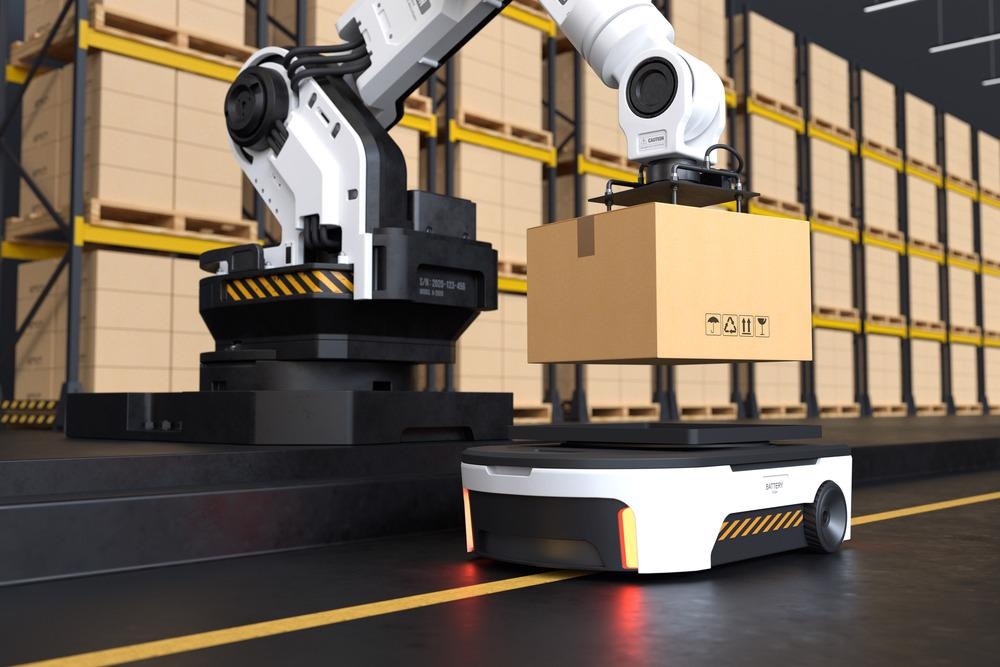Rapidly growing manufacturing industries have instigated the development of automated robotic systems such as automated guided vehicles (AGVs) that can meet the exponentially growing requirements for operational and cost-efficient solutions.

Image Credit: Es sarawuth/Shutterstock.com
With the advent of artificial intelligence (AI) in robotic systems, robots can now replace humans in many places. The deployment of robots to deal with the tasks like material handling, logistics, and production improves not only cost but also operational efficiency and productivity.
Robotic systems are used to automate industrial processes by decreasing human labor, material, and production costs and efficiency. These systems interact with their environment, including humans, using sensors, actuators, and human interfaces to give intelligent services and information.
What are AGVs?
AGVs are portable robots that follow a specific path on the floor, employing radio waves, vision cameras, magnets, and laser-based sensors for navigation. They are most often employed in industrial applications to transport big goods throughout a plant or warehouse.
AGVs can also help manage the business in an effective way by limiting product damage. For example, AGVs are used to manage the goods on a shelf autonomously, thus becoming an effective solution for warehouses and storage facilities.
What are the Main Components of AGVs?
AGVs have essentially five components, including navigation, power, motion, safety, and control systems. The navigation systems gather information to follow a track or direction.
The safety system guarantees safe movements and maneuvers. Safety laser scanners and safety plc are key components. The power system consists of a battery that powers the vehicle and its accessories. The battery and the charging method are essential.
The motion system is responsible for transforming energy into movement. Motors, motor-wheels, and drivers, amongst others, are found here. The AGV's "brain" is the vehicle controller. It collects and coordinates data from other systems, such as navigation, safety, and motion.
Companies Manufacturing AVGs
Several companies have started manufacturing AGVs. They not only manufacture but also provide solutions to the various problems related to AGVs.
Dematic is an AGV manufacturer. Their AGVs transports items fully autonomously with no input from an operator. Dematic AGV Systems employ changeable guide routes to enhance storage, pickup, and transport in compact locations. They seek to boost productivity, reduce product damage, lower labor costs and expand to meet growing automation.
Robotic Automation is another AGV manufacturer which aims to provide AGV models that can be customized with different navigation, interface, and load handling technologies to match the demands of your manufacturing facility, logistics center, and warehouse automation.
Many other companies, such as SEEGRID, Savant Automation, and MAX AGV, are manufacturing and supplying AGVs to industries to augment their production and cost-efficiency.
Advantages of AGVs
Almost every company has already started using AGVs to manage their business. Most companies face difficulties in finding workers for unpleasant and repetitive work. AGVs can help solve their problems by eliminating labor needs. It reduces product damage by substituting forklifts instead of humans.
Automated shelf-to-shipping product movement improves delivery speed and accuracy. Human error-related forklift accidents are eliminated, boosting workplace safety. It increases flexibility by integrating stands, automation, and production processes.
Current Challenges
AGVs have multiple drawbacks. Currently, AGVs are not capable of avoiding obstacles and simply stopping when some hindrance comes in their path. The process of adding additional destinations or routes is currently quite awkward, demanding laser, radio frequency or wire-based guidance, which is a significant constraint on its performance.
The installation and the infrastructure of AGVs are complex and demand more time which ultimately increases the cost. The AGVs currently demand cost-effective and robust ways to solve associated problems and improve their performance.
Future of AGVs
The future of AGVs involves Autonomous Mobile Robots (AMRs). AMRs fed with obstacle avoidance algorithms and onboard sensors can avoid obstacles and calculate the optimal path per their internal map.
It is quite easy to define new or additional routes in AMRs. However, all these advantages come at a cost. The manufacturing cost of AMRs is relatively higher than AVGs because of the sophisticated onboard sensors and algorithms.
The navigation in AMRs is susceptible to environmental disturbances and discontinuities. This may cause robots to lose their positions to some fixed reference which can cause damage to the robot itself as well.
Despite the significant research and progress made in this field, many areas need improvement. Using robust and modern control algorithms along with machine learning (ML) and AI techniques, the performance of these robots can be improved significantly.
References and Further Reading
AGV Network. 'AGV vs AMR. The Truth. What should you buy? Differences? Pros & Cons? - Winner?' Available at: https://www.agvnetwork.com/agv-vs-amr
Dematic. 'Benefits of Dematic AGV Systems'. Available at: https://www.dematic.com/en/products/products-overview/agv-systems/
Robotic Automation. 'AUTOMATED GUIDED VEHICLES (AGV)'. Available at: https://www.roboticautomation.com.au/ra_solutions/automated-guided-vehicles-agv/
RobotWorx. 'Three types of robotic systems'. Available at: https://www.robots.com/articles/three-types-of-robotic-systems
Holovatenko, I. and Pysarenko, A. (2021) 'Energy-Efficient Path-Following Control System of Automated Guided Vehicles', Journal of Control, Automation and Electrical Systems, 32(2), pp. 390–403. Available at: doi.org/10.1007/s40313-020-00668-8.
Li, Q. et al. (2011) 'Design and control of automated guided vehicle systems: A case study', IFAC Proceedings Volumes (IFAC-PapersOnline), 44(1 PART 1), pp. 13852–13857. Available at: doi.org/10.3182/20110828-6-IT-1002.01232.
Oyekanlu, E.A. et al. (2020) 'A review of recent advances in automated guided vehicle technologies: Integration challenges and research areas for 5G-based smart manufacturing applications', IEEE Access, 8, pp. 202312–202353. Available at: doi.org/10.1109/ACCESS.2020.3035729.
Reis, W.P.N. dos, Couto, G.E. and Junior, O.M. (2022) 'Automated guided vehicles position control: a systematic literature review', Journal of Intelligent Manufacturing [Preprint]. Available at: doi.org/10.1007/s10845-021-01893-x.
Disclaimer: The views expressed here are those of the author expressed in their private capacity and do not necessarily represent the views of AZoM.com Limited T/A AZoNetwork the owner and operator of this website. This disclaimer forms part of the Terms and conditions of use of this website.